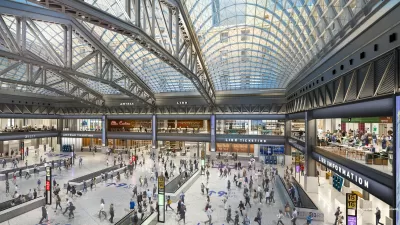CityLab's Eric Jaffe provides an update on the two phases of construction of Moynihan Station, an annex to America's busiest train station. Phase One could be completed next year and Phase Two is in need of a "mere" $200 million. But is that enough?
Moynihan station is the conversion of parts of the adjacent 1912 James A. Farley Post Office, designed by McKim, Mead, and White, which also built the original Penn Station (photo) that was razed in 1963, and the 1919 Hotel Pennsylvania opposite Penn Station on Seventh Ave.
Erik Jaffe of CityLab writes that "Phase One of that project, which should provide better platform access for Amtrak riders, is already underway and may be completed as early as next year. The problem has long been a lack of funding for Phase Two—a grand new train hall filled with retail stores and, if one can believe the renderings, quite a bit more breathing room."
Last week the New York Times reported that Phase Two funding might be closer than previously believed. The Times quotes Senator Charles Schumer, a Moynihan Station proponent, as saying that the city and two developers (Related Companies and Vornado Realty Trust) have pledged $500 million for the great hall, leaving only a $200 million gap. Schumer called on the federal government to make up the difference.
But here's the kicker: According to Michael Kimmelman, architecture critic for The New York Times, the annex helps out only 5 percent of Penn Station's travelers, as he noted here in 2012.
Jaffe points to a column by his colleague, Ben Kabak of 2nd Ave. Sagas, who "reminds us, Moynihan Station would do nothing to address the biggest pressing need for Penn Station: more train capacity under the Hudson River. Unless that shortcoming is addressed, he writes, Moynihan Station will become a 'nicer shell for an older problem'"
Last word to Kabak: "For $1 billion, the Moynihan Station Development Corporation is creating a nicer waiting room for Amtrak without contemplated or expanded train capacity through the station. There's no denying that Penn Station needs fixing...But as dollars for transit are scarce, the priority should be expanding trans-Hudson capacity."
Look for a forthcoming post on just that: "expanding trans-Hudson capacity."
FULL STORY: A New Penn Station Wing for Amtrak in New York May Be Closer Than We Thought

Study: Maui’s Plan to Convert Vacation Rentals to Long-Term Housing Could Cause Nearly $1 Billion Economic Loss
The plan would reduce visitor accommodation by 25,% resulting in 1,900 jobs lost.

North Texas Transit Leaders Tout Benefits of TOD for Growing Region
At a summit focused on transit-oriented development, policymakers discussed how North Texas’ expanded light rail system can serve as a tool for economic growth.

Why Should We Subsidize Public Transportation?
Many public transit agencies face financial stress due to rising costs, declining fare revenue, and declining subsidies. Transit advocates must provide a strong business case for increasing public transit funding.

How to Make US Trains Faster
Changes to boarding platforms and a switch to electric trains could improve U.S. passenger rail service without the added cost of high-speed rail.

Columbia’s Revitalized ‘Loop’ Is a Hub for Local Entrepreneurs
A focus on small businesses is helping a commercial corridor in Columbia, Missouri thrive.

Invasive Insect Threatens Minnesota’s Ash Forests
The Emerald Ash Borer is a rapidly spreading invasive pest threatening Minnesota’s ash trees, and homeowners are encouraged to plant diverse replacement species, avoid moving ash firewood, and monitor for signs of infestation.
Urban Design for Planners 1: Software Tools
This six-course series explores essential urban design concepts using open source software and equips planners with the tools they need to participate fully in the urban design process.
Planning for Universal Design
Learn the tools for implementing Universal Design in planning regulations.
City of Santa Clarita
Ascent Environmental
Institute for Housing and Urban Development Studies (IHS)
City of Grandview
Harvard GSD Executive Education
Toledo-Lucas County Plan Commissions
Salt Lake City
NYU Wagner Graduate School of Public Service



























